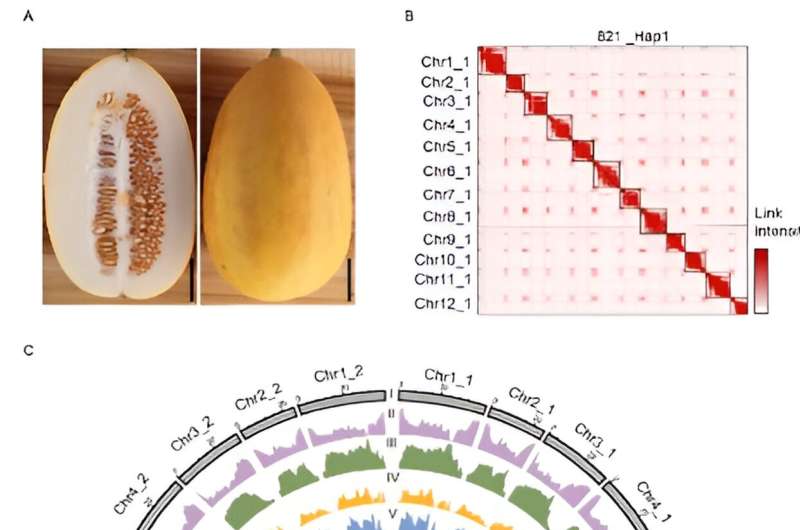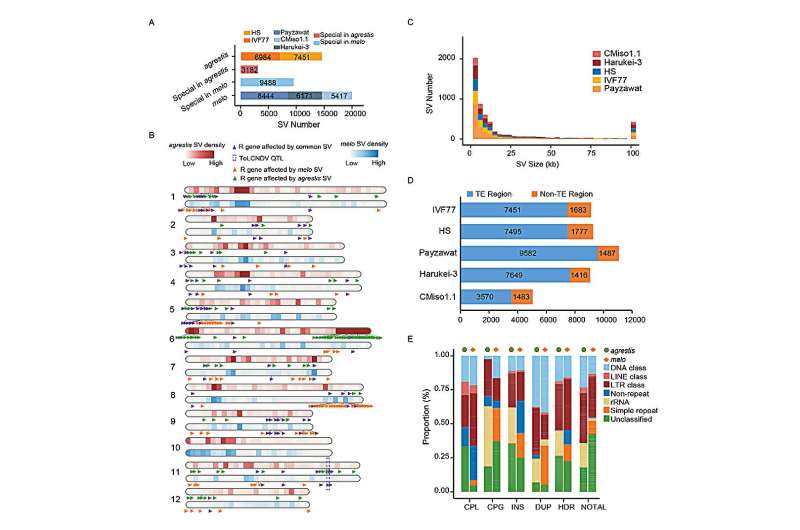This article has been reviewed according to Science X's editorial process and policies. Editors have highlighted the following attributes while ensuring the content's credibility:
fact-checked
peer-reviewed publication
trusted source
proofread
Scientists assemble first semi-wild-type melon T2T genome

Melon (Cucumis melo L.) is an important vegetable crop that has an extensive history of cultivation, and has been classified into two subspecies, C. melo ssp. agrestis and C. melo ssp. melo.
Previous studies suggest that the two subspecies were domesticated independently, which may have generated different genetic mechanisms for the same trait between the two subspecies. Furthermore, the difference in their geographical distribution resulted in diverse characteristics between the two subspecies, shaping genomic imprinting in their genomes.
Wild germplasm is an important genetic resource in crop breeding because of its high genetic diversity and resistance against diseases. However, all of the previous reported genomes were assembled based on the cultivated melon, the genome of wild and semi-wild melon types is not yet available. Therefore, assembling high-quality wild/semi-wild melon genome will provide an unprecedented opportunity for gene discovery and resistance breeding in melon.
A study titled "The haplotype resolved T2T reference genome highlights structural variation underlying agronomic traits of melon" has been published in Horticulture Research. Yongyang Xu, from Melon Genetic Breeding Team of Zhengzhou Fruit Research Institute, Chinese Academy of Agricultural Sciences, cooperated with professor Tao Lin from China Agricultural University.
PI 313970 is an accession derived from C. melo ssp. agrestis var. acidulus native to India, which possess high resistance to powdery mildew and a variety of viral diseases (ToLCNDV, CYSDV, CABYV, WmCSV and CuLCrV). The '821' accession was self-fertilized from PI 313970 for several generations. Here we reported a chromosome-level T2T genome assembly for 821 (C. melo ssp. agrestis var. acidulus), a semi-wild melon with two haplotypes of ~373 Mb and ~364 Mb, respectively.

Comparative genome analysis discovered a significant number of structural variants (SVs) between melo and agrestis genomes, including a copy number variation located in the ToLCNDV resistance locus on chromosome 11, of which a candidate gene was identified for ToLCNDV resistance.
Melon is a unique model species for studying fruit ripening because of presenting both climacteric and non-climacteric types. Genome-wide association studies detected a significant signal associated with climacteric ripening and identified one candidate gene CM_ac12g14720.1 (CmABA2), encoding a cytoplasmic short chain dehydrogenase/reductase, which controls the biosynthesis of abscisic acid. This study provides valuable genetic resources for future research on resistance breeding in melon.
More information: Guoli Li et al, The haplotype-resolved T2T reference genome highlights structural variation underlying agronomic traits of melon, Horticulture Research (2023). DOI: 10.1093/hr/uhad182
Journal information: Horticulture Research
Provided by NanJing Agricultural University





















